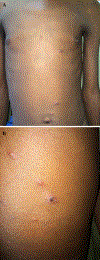HIV-Related Skin Disease in the Era of Antiretroviral Therapy: Recognition and Management
- PMID: 30806959
- PMCID: PMC6581453
- DOI: 10.1007/s40257-019-00422-0
HIV-Related Skin Disease in the Era of Antiretroviral Therapy: Recognition and Management
Abstract
Antiretroviral therapy (ART) has revolutionized the treatment and prognosis of people living with HIV (PLHIV). With increased survival and improved overall health, PLHIV are experiencing dermatologic issues both specific to HIV and common to the general population. In this new era of ART, it is crucial for dermatologists to have a strong understanding of the broad range of cutaneous disease and treatment options in this unique population. In this review, we outline the most common skin diseases in PLHIV, including HIV-associated malignancies, inflammatory conditions, and infections, and focus on the role of ART in altering epidemiology, clinical features, diagnosis, and treatment of cutaneous conditions.
Conflict of interest statement
Khatiya Chelidze has no conflicts to disclose.
Cristina Thomas has no conflicts to disclose.
Aileen Yenting Chang has no conflicts to disclose.
Esther Ellen Freeman has no conflicts to disclose.
Figures







Similar articles
-
[Psoriasis and HIV infection].Actas Dermosifiliogr. 2008 Dec;99(10):753-63. Actas Dermosifiliogr. 2008. PMID: 19091213 Review. Spanish.
-
[Systemic pharmacotherapy in dermatology. Progress and challenges].Hautarzt. 1998 Jun;49(6):509-15. doi: 10.1007/s001050050780. Hautarzt. 1998. PMID: 9675582 German. No abstract available.
-
Dermatologic manifestations of HIV infection.Top HIV Med. 2005 Dec-2006 Jan;13(5):149-54. Top HIV Med. 2005. PMID: 16377853 Review.
-
HIV-related CD8+ cutaneous pseudolymphoma: efficacy of methotrexate.Dermatology. 2013;226(1):15-8. doi: 10.1159/000346242. Epub 2013 Jan 22. Dermatology. 2013. PMID: 23343593 Review.
-
Systemic Inflammation and the Increased Risk of Inflamm-Aging and Age-Associated Diseases in People Living With HIV on Long Term Suppressive Antiretroviral Therapy.Front Immunol. 2019 Aug 27;10:1965. doi: 10.3389/fimmu.2019.01965. eCollection 2019. Front Immunol. 2019. PMID: 31507593 Free PMC article.
Cited by
-
Global Disparities in Skin Cancer Services at HIV Treatment Centers across 29 Countries.J Invest Dermatol. 2021 Oct;141(10):2533-2536.e2. doi: 10.1016/j.jid.2021.02.758. Epub 2021 Apr 14. J Invest Dermatol. 2021. PMID: 33864771 Free PMC article. No abstract available.
-
Isolated collagenoma in an HIV-positive patient on ART: a case report.BMC Infect Dis. 2023 Sep 2;23(1):571. doi: 10.1186/s12879-023-08548-7. BMC Infect Dis. 2023. PMID: 37658302 Free PMC article.
-
The prevalence and spectrum of mucocutaneous disease in South African people living with HIV and accessing care at a district-level hospital.South Afr J HIV Med. 2020 Dec 10;21(1):1154. doi: 10.4102/sajhivmed.v21i1.1154. eCollection 2020. South Afr J HIV Med. 2020. PMID: 33354365 Free PMC article.
-
Case Report: Role of Point-of-Care Ultrasound in the Diagnosis of Bacillary Angiomatosis.Am J Trop Med Hyg. 2023 May 9;109(1):38-41. doi: 10.4269/ajtmh.22-0675. Print 2023 Jul 5. Am J Trop Med Hyg. 2023. PMID: 37160274 Free PMC article.
-
Magnitude of opportunistic infections and associated factors among adult people living with human immune deficient virus on art at selected public hospital, mogadishu somalia: cross-sectional study.Ann Med Surg (Lond). 2023 Jun 6;85(7):3364-3371. doi: 10.1097/MS9.0000000000000880. eCollection 2023 Jul. Ann Med Surg (Lond). 2023. PMID: 37427157 Free PMC article.
References
-
- Chang Y, Cesarman E, Pessin MS, Lee F. Identification of herpesvirus-like DNA sequences in AIDS-associated Kaposi’s sarcoma. Science 1994;266(5192):1865. - PubMed
-
- Albini A, Aluigi M, Benelli R, Berti E, Biberfeld P, Blasig C, et al. Oncogenesis in HIV-infection. Int J Oncol 1996;9(1):5–8. - PubMed
-
- Chang Y, Ziegler J, Wabinga H, Katangole-Mbidde E, Boshoff C, Schulz T, et al. Kaposi’s sarcoma-associated herpesvirus and Kaposi’s sarcoma in Africa. Uganda Kaposi’s Sarcoma Study Group. Arch Intern Med 1996;156(2):202–4. - PubMed
Publication types
MeSH terms
Substances
Grants and funding
LinkOut - more resources
Full Text Sources
Medical

